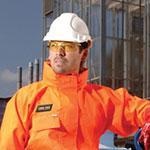Saving your skin from chemical splash
Tuesday, 09 April, 2013
Growing industries across Australia including mining, oil and gas, petrochemical, metallurgy and heavy manufacturing have seen a huge increase in the use of caustic liquids and chemical solvents in the manufacturing and maintenance process of many business. From chemical separations, alkylation, electripolishing, anodising, phosphating, caustic cleaning through to fuel management - all require the material handling of potentially dangerous chemicals that can cause life-threating burns from chemical splash.
Each industrial sector uses many chemical agents in its manufacturing processes such as:
- Coatings - Paints, solvents, resins, polyurethanes, oils.
- Surfactants - Hydrochloric acid, nitric acid, phosphoric acid, sulfuric acid, acetic acid.
- Bases - Sodium and potassium hydroxides, lime; solvents; colourants and wastes.
- Mechanical liquids - Engine coolants, heat transfer fluids, oil-soluble colourants, hydraulic fluids, fuel additives.
- Machinery fuels - Jet A-1, diesel, Naphtha, engine oils, all of which are a major chemical splash risk.
What are the chemical splash danger areas?
Petrochemical
Operations: Handling chemicals or adding chemical agents.
Inspection: Handling mistakes when testing or analysing the products and sampling.
Stock management: Unloading, storing, and transfer of chemicals from a container or a tank to another one.
Maintenance: Operations of draining, cleaning, sanitation, and purging.
Mining, oil and gas
Solvent extraction: Separation of one or more substances from a mixture by treating an aqueous solution of the mixture with a solvent that will extract the required substances, leaving the other undesirable materials behind.
Leaching: Extracting a soluble metallic compound from an ore by selectively dissolving it in a suitable solvent, such a water, sulfuric acid or sodium cyanide solution.
Refining: Electrolytic or chemical process that produces a pure metal.
Flotation: Chemicals are added to a crushed ore-water slurry to recover the mineral.
Heavy manufacturing
Plant operations: Use of chemicals such as adhesives, acids, bases and cleaning chemicals.
Manufacturing: Electrochemical and chemical milling, corrosion inhibition liquids, heat transfer fluids and coolants, oil-soluble colourants, hydraulic fluids, fuel additives - efficient and ecological.
Maintenance: Solvents used for different tasks of preparation of surfaces, such as cleaning, degreasing and pickling.
Metallurgy
Electropolishing: Commonly used electrochemical method for smoothing, polishing, deburring and cleaning various metals.
Aqueous cleaning: The workpieces are placed in this process solution for several minutes.
Pickling: Pickling is a chemical procedure used to brighten and/or remove oxides from the metallic surface prior to other surface treatment processes with an acid-based pickling agent.
Anodising: The anodising of metals is an electrolytic surface oxidation process which enhances the natural aptitude for the metal to oxidise.
Phosphating: The treatment of a surface with a diluted solution of hot phosphoric acid allows its passivation.
What is the best way to protect your team?
To protect operational teams responsible for handling chemicals on-site, there has been an increase in development of chemical splash and Hazmat apparel designed to withstand splash and gaseous dangers face during the handling of chemical materials.

The latest generation of chemical splash suit fabrics is constructed with a breathable hydrophilic polytetrafluoroethylene PTFE laminate made from a high-performance, high-quality, 5-layer, breathable fabric manufactured specifically for the requirements for chemical splash protection. These fabrics allow heat vapour to transfer through the fabric while preventing liquid penetration by a variety of chemicals. As these materials allow the body to ‘breathe’, so your perspiration can evaporate reducing the possibility of heat stress and therefore improving wearer comfort.
The multiple layers in these new fabrics include a chemical-, oil-, soil-repellant treatment on the outer fabric, 300D Oxford outer fabric, moisture vapour permeable PU hydrophilic coating, moisture vapour permeable microporous PTFE film membrane and Tricot nylon knit liner.
Chemical splash suits made from Chemtech have been highly tested to ensure that they provide high protection against chemical splash including to the following standards: AS4602.1999, EN471:2008, EN1149-1:1995, AS2755.1-1985, AS/NZS ISO 6530-2006, AS3765.1:1990 and GB12012-1989. Chemtech fabrics have also been tested against liquid chemicals including hydrochloric acid 37%, sodium hydroxide 40%, jet fuel A1 100%, sulfuric acid 98%, Toluene, tetrachloroethylene and nitric acid 50%.
Smoke complexity, skin absorption and protective equipment in firefighter safety
To address health and safety questions raised by Australian firefighters, researchers have...
Will silicosis compensation costs rise despite Victoria's engineered stone ban?
Monash University researchers have explored whether silicosis compensation costs are set to...
Army aims to combat heat risk with wearable monitor prototype
A wearable heat risk monitor prototype for the Australian Defence Force is being trialled by Army...










